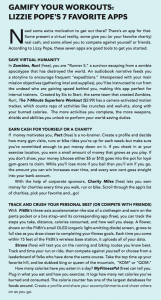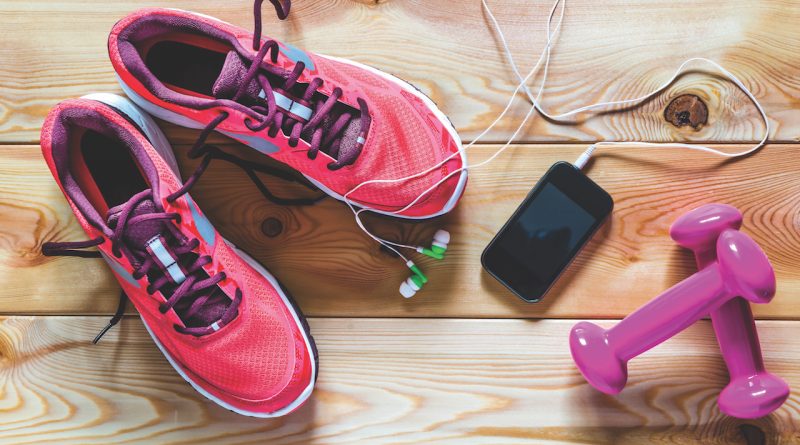The Fitness Game: 7 Apps To Gamify Your Workouts
A UVM researcher and a game developer team up to create a fitness game that they hope will help burn calories.
It’s 5:30 a.m., and your alarm is buzzing. You set it for an extra-early hour so you could get in a 10K run before work. You hit ‘snooze’ and roll over as the debate plays out in your head: Are you really getting up this early?
Then you remember: You bet $10 on Pact, an app that gives you money if you complete your fitness goals. The bet: that you would run three times this week. If you go, you’ll make a $1. If you don’t, you’ll lose the $10.
According to Lizzy Pope, Director of the Didactic Program in Dietetics at the University of Vermont, that small incentive might help you get up earlier, even if you aren’t using the app and the money stops coming. “Once you have a habit started, it’s possible you will become intrinsically motivated,” she said.
Apps like Pact that motivate you to exercise have soared in popularity over the last several years. Some incentivize fitness, whether the reward is actual money, or just the chance to compete with friends. Others, like MyFitnessPal, allow you to track specifics about your exercise routine—number of steps, length of a  ride—to help you meet goals and compete against yourself. Some, like Pokémon Go (whose popularity peaked last September at 27 million downloads per day) weren’t even designed to be fitness apps, but got people moving anyway.
ride—to help you meet goals and compete against yourself. Some, like Pokémon Go (whose popularity peaked last September at 27 million downloads per day) weren’t even designed to be fitness apps, but got people moving anyway.
‘Gamification’—using gaming and rewards to motivate a behavior—might be booming right now, but can it whip you into shape? Pope has spent several years trying to answer that question. She studies the factors, intrinsic (in this case, a genuine love for fitness) and extrinsic (driven by incentives or, for example, the desire to look good), that motivate us to exercise.
Most recently, she’s been testing gamification on the people who love games most: kids, Burlington high school kids, specifically. With the help of Marguerite Dibble and her team at Burlington-based game design company Game Theory, Pope created Camp Conquer: a game that pits the 100 participating high schoolers against each other in an epic virtual water balloon fight.
Here’s how it works: the participants, are given FitBits to count their steps and divided up into two teams, red and blue. In the game, steps turn into gold coins, which can be cashed in for different sizes and qualities of water balloons. The more you walk or run, the more and better balloons you get.
In the mornings, the kids log into Camp Conquer on their computers to load up their water balloons and choose strategic positions in the game’s virtual playing field. Then, in the middle of the day, the fight automatically plays out. Usually, the team with the most and best water balloons–meaning the team that has collectively taken the most steps–wins.
Pope wants to know if the game will motivate these high schoolers, who are mandated by Vermont State Law to exercise for at least 30 minutes during the school day, to exercise more than they normally would. She won’t see the results for another few months, but if it works, she hopes the game will be worked into school curriculums around the state.
“Kids are on their screens a lot as it is, so if they’re going to play games, why not play this game, where the currency comes from being active?” she said.
But as with any fitness app, in order to make the game effective, it needed motivational tools that were strong enough to pull kids away from other temptations—phones, friends, sleeping—and make them want to exercise.
With adults, that extrinsic motivation may come from money, but for teenagers, it’s socializing. Pope and Dibble designed the game so that team members succeed when more people participate. Plus, the players who bring in the most gold coins get the title “MVP,” which comes with an honorary gem.
Pope admits that it seems a bit backwards to use a screen as a gateway to exercise, but if it creates a habit, she says she’s done her job.
“The hope is that you can get someone intrinsically motivated to exercise, but realistically, research has shown that for some people, you need to try to increase their extrinsic motivation by providing outside rewards,” she said.
Pope has tested this theory with other studies, one of which involved paying first-year college students to go to the gym. Over a course of two semesters, she split 117 first-year college students into three groups: a group that received no incentive for going to the gym, a group that received $5 for each gym visit in the first semester and no incentive in the second semester, and a group that received $5 per gym visit both semesters. Pope measured gym visits when the students used their IDs to swipe into the fitness center.
It worked: 62 percent of the students who were paid to work out met their fitness goals, while only 13 percent of the control group, which was not receiving incentive, met their goals. But through surveys, she also found that the incentivized students were happy with the way they felt while going to the gym, indicating that the students had gained intrinsic motivation to be physically fit. “It appears that provision and then discontinuation of monetary incentives did not negatively impact intrinsic motives to exercise for our participants,” her study concludes.
For Pope, that’s reason enough to keep the incentives coming. “I think about the American population, and how important good exercise is to good health, and also mental health, and we’re just not doing it,” she says. “So then it’s like, why not incentivize it?”
Then there are those of us who don’t need incentives—the endorphins, fresh air and the satisfaction of pushing ourselves is enough. But maybe we need a little help waking up early, or maybe we enjoy comparing our daily stats with our friends’. Maybe earning a dollar every time we show up at the fitness center is easy money in our pockets.
“I’m a weird case, because you’d have to pay me not to exercise,” Pope says. “We’re just throwing out a bunch of motivational strategies. Some will work for one person or another, but none of them will work for everyone. We need all these things in our toolbox to encourage people to get out there.”

